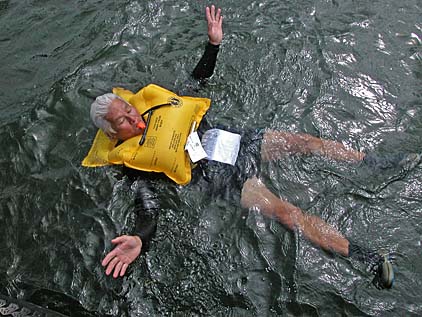

|
Staying afloat
Sales of life vests and emergency
transmitters surge after a rescue at sea
|
Sales of emergency boating equipment have shot up because of news that orange life vests helped save two Navy sailors adrift for 20-plus hours after their boat sank last weekend.
Boating Safety Tips
» Wear your life jacket: Drowning is the No. 1 cause of death in boating accidents. In Hawaii, keiki under 13 must wear a life jacket.
» Never boat under the influence of drugs or alcohol. » Be weather wise: Always get a weather forecast before casting off. Hurricane season in Hawaii is June 1-Nov. 30. » Be visible. Display navigational lights from sunset to sunrise and during limited visibility. » Can you call for help? Hawaii law requires all boaters going more than a mile offshore to carry a EPIRB or WHF radio. » Do it for your ohana. Leave a "float plan" of where you are going in your boat with friends or family. » Are you in the know? Take a safe boating course. Obtain Hawaii-specific information. » Be prepared. Check expiration dates on your safety equipment.
Source: State Department of Land and Natural Resources
|
Officials at the state Department of Land and Natural Resources are hoping the incident will make other boaters take precautions before setting sail.
"The ocean has taken some lives this year," said Earl Omoto, senior harbormaster at the Heeia Kea Boat Harbor. Four recreational fishermen have died in three separate accidents this year.
DLNR officials want life vest use to become as common as car seat belt use, said Pearlyn Fukuba, DLNR boating safety director.
While conventional vests cost between $30 and $70, many people do not use them because they are bulky. But DLNR officials said there are many newer types of self-inflating vests that are easy to use.
Omoto demonstrated a self-inflating fanny pack version at Heeia Kea Boat Harbor last week. Omoto began treading water and initially had trouble locating the plastic pull, which had been tucked under his waistband. But once he located the tab and tugged, the bright yellow life vest inflated, and he slipped it over his head.
The fanny pack version, weighing less than two pounds, comes in a small Denier nylon pouch and is worn around the waist in the front or back but must be brought in front before inflating.
A version similar to an airplane vest worn around the neck is recommended for the nonswimmer and the less agile.
The DLNR also suggests wearing a whistle designed for use in the water, which can be heard over the drone of a boat's engine.
Omoto said he once lost his voice after yelling for a boat 100 yards away, and now swears by them.
Hawaii laws passed in June 2003 require that children under 13 wear life vests while a boat is underway (the self-inflating are not yet available for children) and an EPIRB and a VHF radio on board a boat that travels beyond one mile or more from shore.
Hawaii is the first state to require EPIRBs and VHF radios.
Omoto said boaters also should remember "STOP" -- stop, think, observe and plan. When using a VHF radio, the "main thing is get a quick location, not just yell, 'Help, help.'"
The most common mistake by boaters is "underestimating Mother Nature," he said.
DLNR urges preparation by knowing the weather and the tides, and filing a float plan.
www.state.hi.us/dlnr/